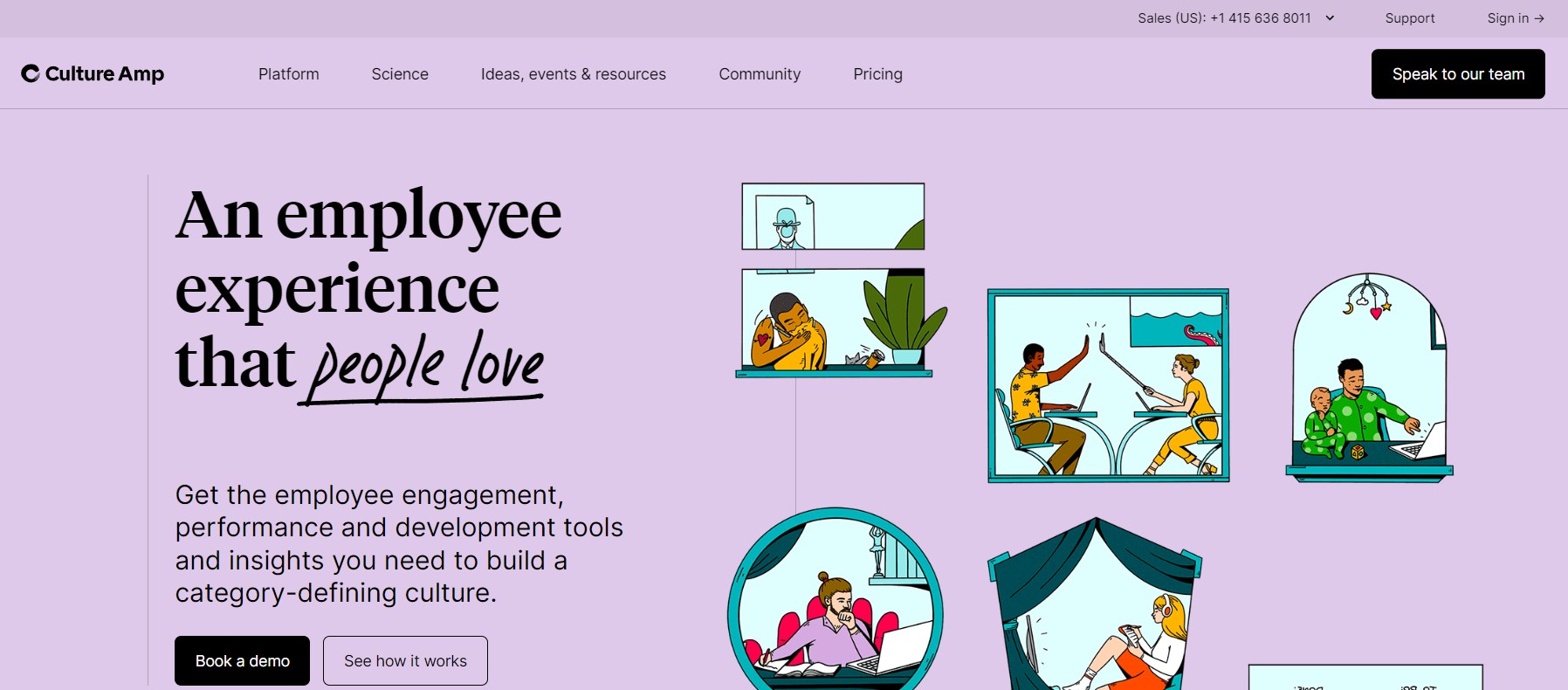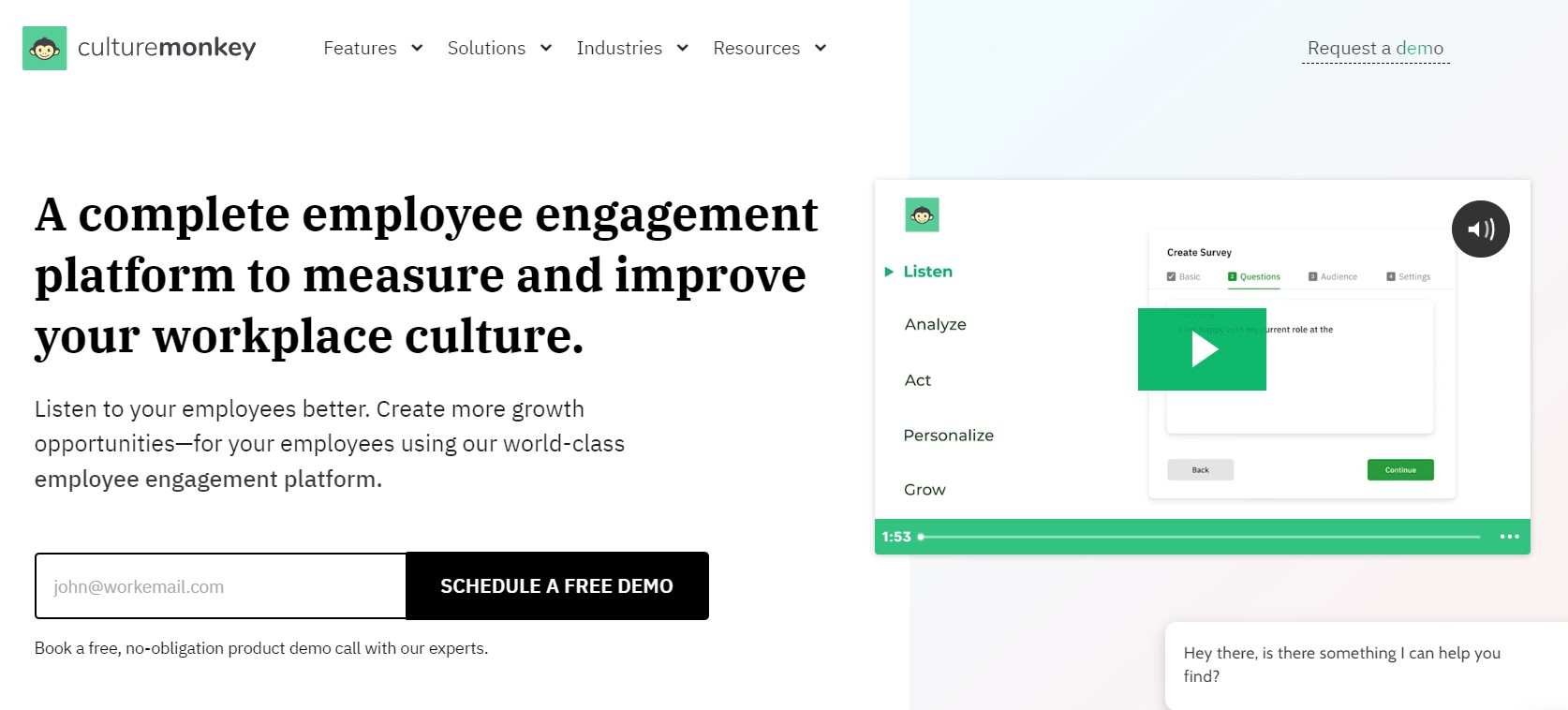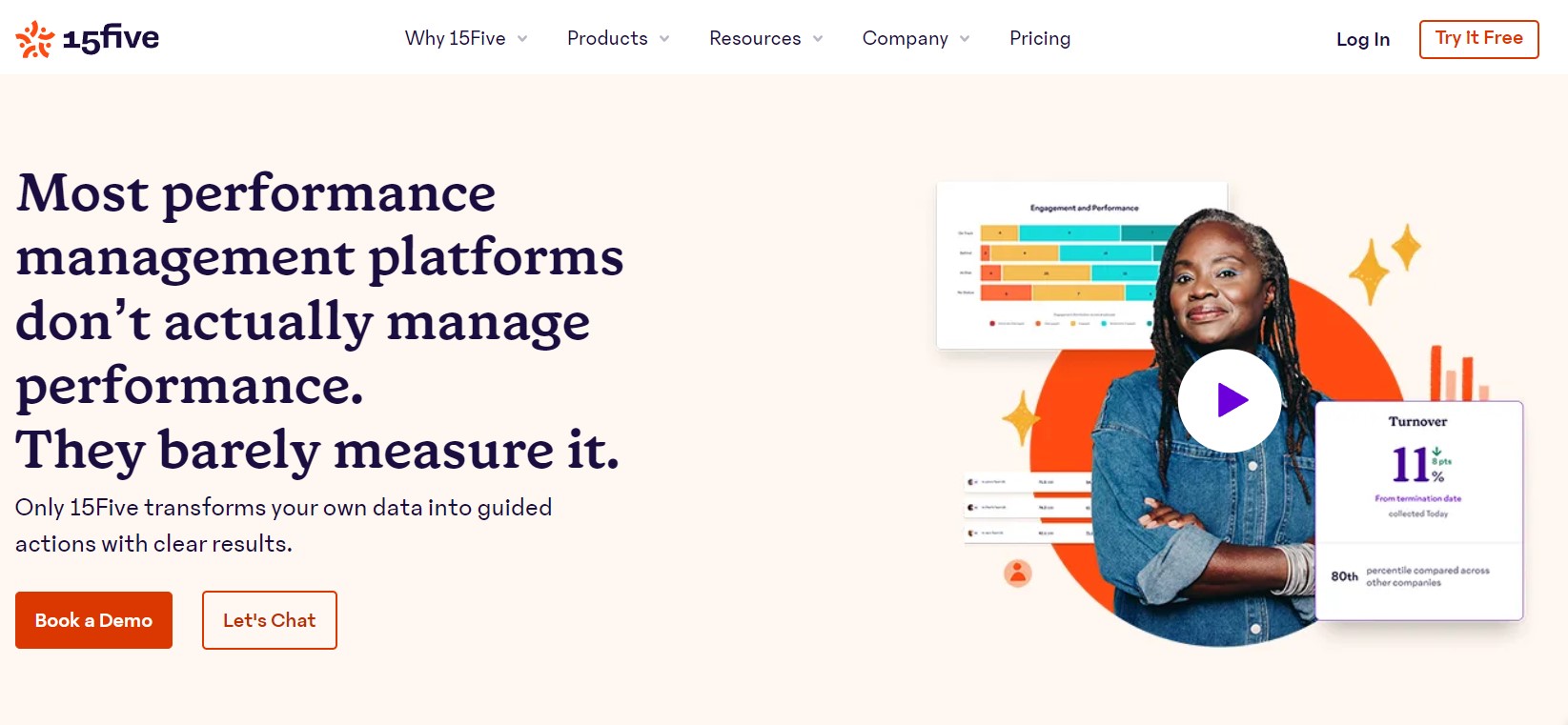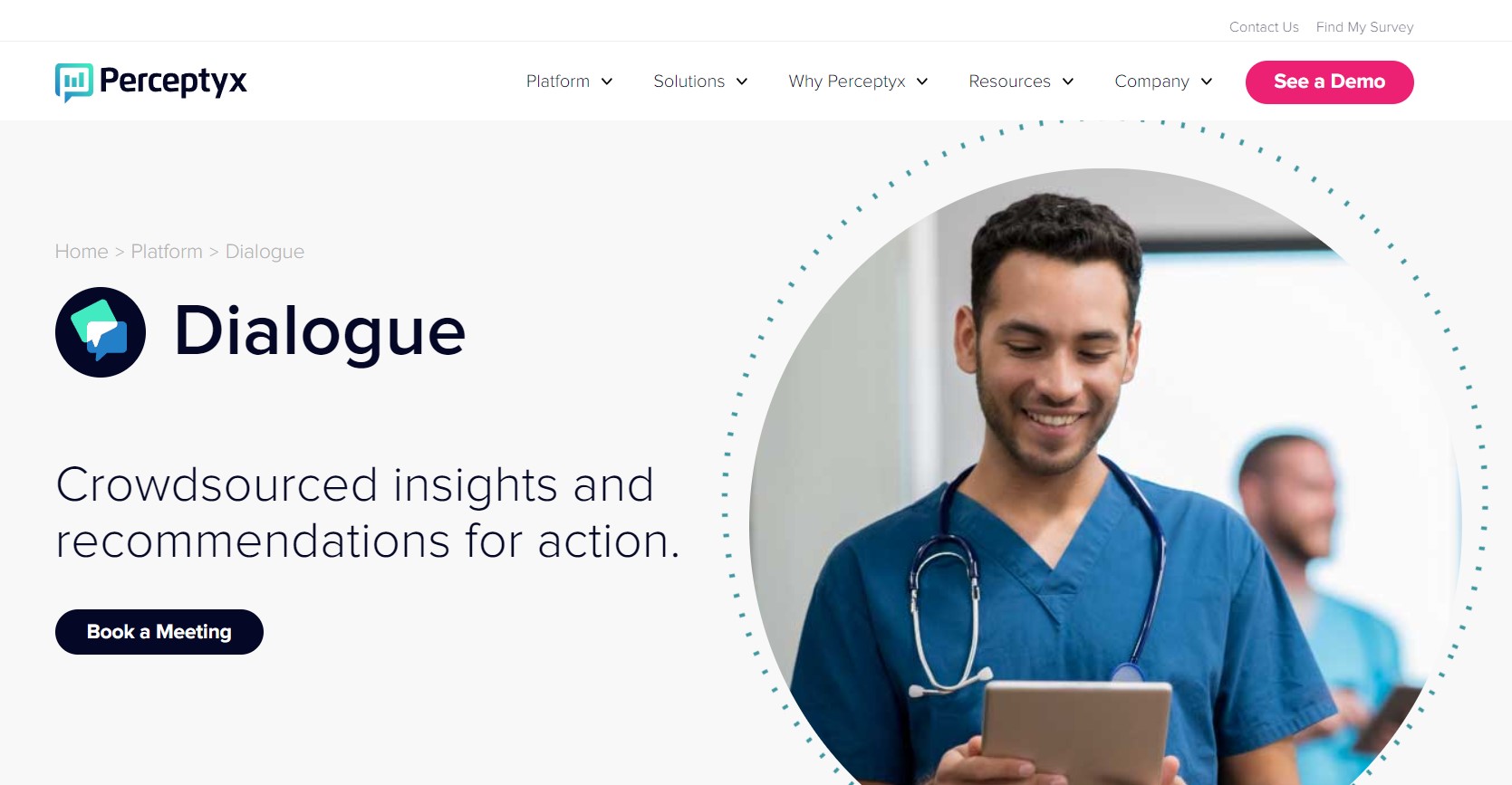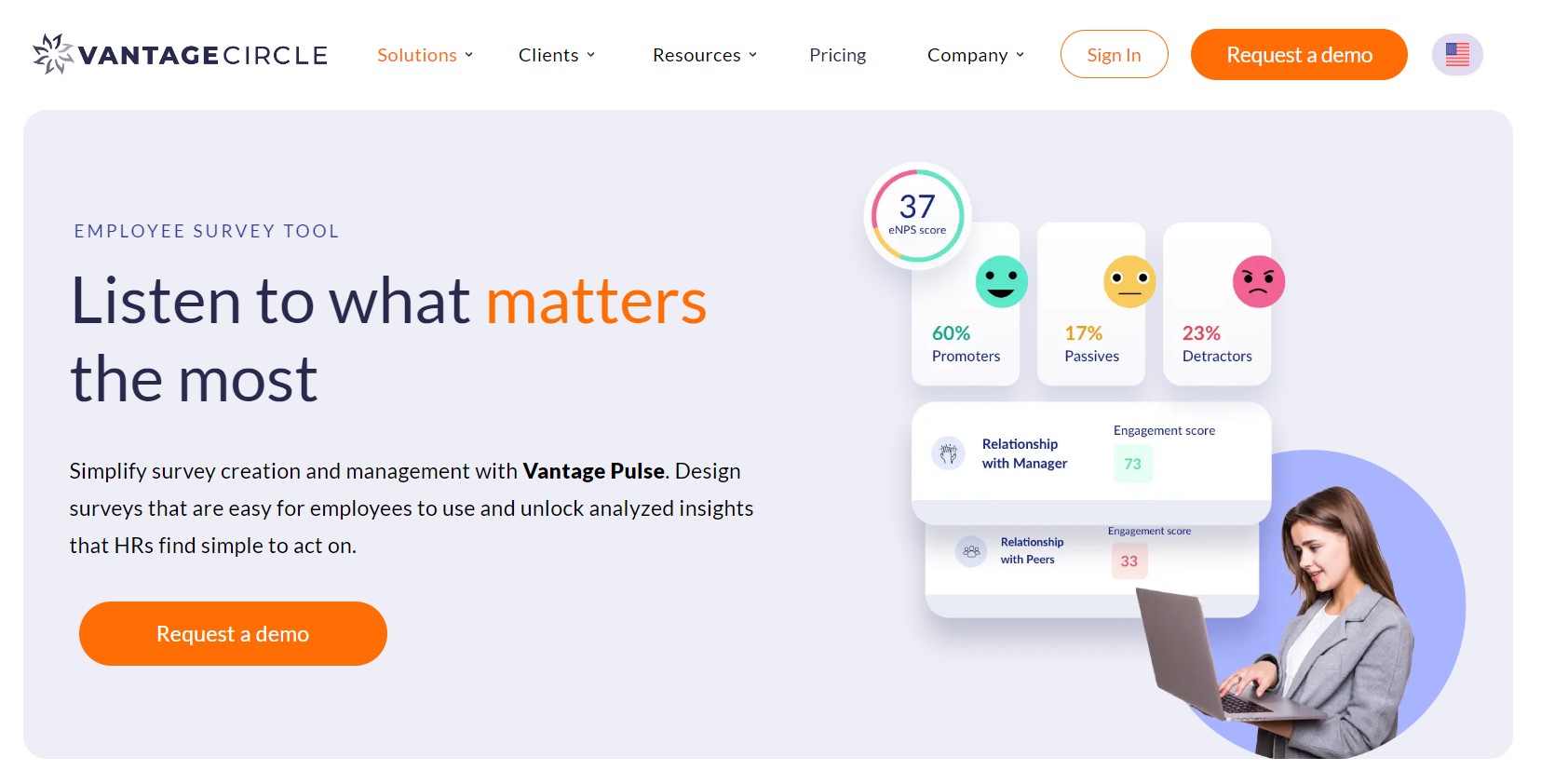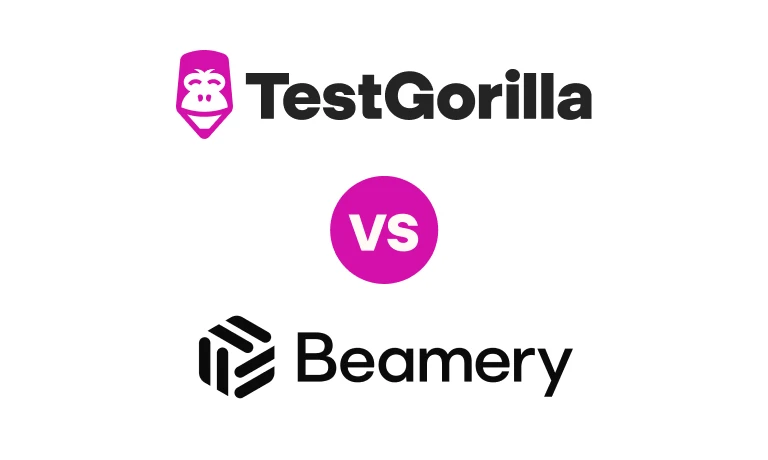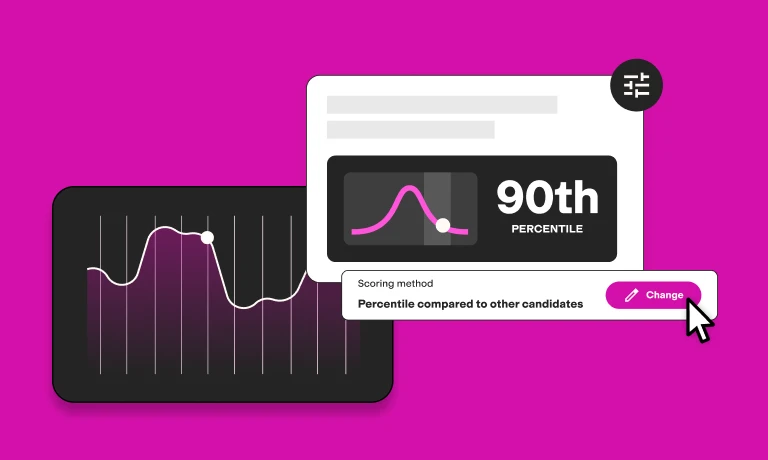Employee pulse survey tools: A guide for HR professionals wanting better workforce insights
Employees are the lifeblood of your company, so it’s essential to keep them satisfied.
Issues like burnout and quiet quitting damage employee motivation, and if people feel like they lack development opportunities, they start looking for a company that provides them.
You need visibility into these problems, but manually delivering and analyzing employee surveys is time-consuming and exhausting, especially with larger workforces.
Employee pulse survey tools are an excellent way to capture and act on this vital data.
Survey software enables HR professionals to get deep insights into how their workforce functions – what’s good, what needs improvement, and where opportunities lie.
This HR technology helps you spot trends and make strategic decisions, increasing retention, engagement, and satisfaction.
Our article discusses the benefits of using employee pulse survey tools and our top software recommendations. We also list five best practices for getting the most out of your survey system.
Table of contents
- What is an employee pulse survey?
- Why are employee pulse survey tools important to HR professionals?
- The benefits of employee pulse surveys
- 5 best employee pulse survey tools
- 5 best practices for leveraging employee pulse survey software in your HR department
- 3 examples of companies succeeding with employee pulse survey tools
- Use employee pulse survey tools and build a better workplace
- Employee pulse survey FAQs
What is an employee pulse survey?
An employee pulse survey is a set of questions delivered to staff regularly. They aim to discover staff opinions about roles, relationships, communication, and work environment.
Companies then analyze and use these insights to improve working conditions and practices.
Employee pulse surveys are key to discovering crucial insights that help retain, engage, and satisfy your workforce.
They’re generally quarterly or monthly but can also be weekly.
This type of survey frequency makes them much more effective than traditional engagement surveys, which are typically yearly.
Staff pulse surveys are personal to each organization and contain questions about your company. They may have a few standardized questions, but you must customize them to address your workforce, organizational needs, and processes.
Regular surveys are critical to your employee listening strategy, making them a worthy investment.
Why are employee pulse survey tools important to HR professionals?
Listening to your employees’ voices is essential for optimizing and improving your company.
Asking for your employees’ thoughts and opinions gives you information about their engagement and satisfaction and opens up potential process bottlenecks and work conflicts.
Modern companies recognize the power of staff pulse surveys. A 2023 survey showed that 95% of respondents had a formal employee listening program, and 70% intended to further accelerate these practices.
Increasingly, more organizations issue surveys, but few companies have the time to create, deliver, and manage them. Further, it’s nearly impossible to analyze the results without digital tools.
Many HR technology trends are employee-centric because of the recent focus on employee satisfaction.
Other tools in this category are wellness platforms and employee recognition software. The war for talent and a skills shortage make employee satisfaction and happiness top priorities to retain and attract great people.
Use pulse surveys to react to employee feedback faster than with annual employee engagement surveys, helping you improve practices and increase engagement and retention.
The best insights on HR and recruitment, delivered to your inbox.
Biweekly updates. No spam. Unsubscribe any time.
The benefits of employee pulse surveys
Employee pulse surveys aim to discover what’s working and what isn’t in your organization, getting to the heart of crucial issues so you can take action.
Employee pulse survey tools improve the employee experience and encourage a healthier company culture.
1. Increase employee engagement
Employee engagement is one of the most common metrics to measure in pulse surveys, and it greatly improves when you commit to them.
Employee pulse survey questions should uncover valuable insights about how employees feel about:
Growth
Teamwork
Contribution
Basic needs
Use employee pulse survey tools to examine these employee needs continuously and then take prompt action. Experts recommend this as the most reliable way to boost employee engagement.
Employee pulse survey software is also an effective tool to engage a distributed workforce.
It’s far too easy for flexible workers to lose motivation and feel excluded without the right hybrid work technology.
2. Improve employee retention
A lot of employee turnover and attrition comes from unaddressed needs, which often stem from a lack of internal communication.
For example, your employees could be quitting because of a lack of development opportunities. You’re in the dark without a simple way to collect feedback.
Experts agree that feedback is an essential element in employee retention. Further, the opinions of the employees who left are crucial to improving your organization – but their opinions leave with them.
If employees are frustrated with something but don’t have a way to express it, they start looking for a new job.
It goes beyond the fact you didn’t accommodate them – you didn’t even have a chance to because you didn’t know about their struggles.
Employee listening affects retention most effectively when you start from the beginning of the employee life cycle. We recommend using employee onboarding software and staff pulse surveys to gather early feedback from new hires and build a strong foundation.
3. Enable you to monitor employee trends
Regular surveys help you capture trends as they develop rather than yearly.
For example, you might notice a decline in job satisfaction soon after introducing a new project management tool.
Employee pulse survey tools give you context for “good” numbers.
You may think that employee engagement at 75% is great, but if you do regular surveys, you notice that it was 80% in the past quarter – so it’s trending downward.
This trend could become a serious problem. Disengaged employees are only a step away from quiet quitting or doing the bare minimum at work.
The purpose of employee pulse surveys is to capture this information in real time so you can take action.
4. Builds a good company culture
Listening to your employees’ voices creates a healthy company culture. It shows your staff that their opinions matter and that you take action to create a better environment.
Actively seeking workforce perspectives increases employees’ opinions of the organization and their overall trust – 89% of HR leaders agree that regular feedback and check-ins improve organizational culture. [1]
This cultural improvement is also significant for your employer branding, improving employee referrals and attracting new talent.
Employee pulse survey tools are also key to building a more cohesive culture for remote and contingent workers. This software and a solid vendor management system help you manage healthy relationships and collect valuable feedback.
5 best employee pulse survey tools
The benefits of employee pulse surveys are worth taking advantage of immediately, but you can’t buy the first software you see.
Our list of employee pulse survey tools helps you discover which tech best fits your HR tech stack, discussing pros and cons, pricing, and top features.
Factors we considered
Here’s a brief overview of what matters when choosing a survey tool for your company:
Customization: Personalization is essential for survey software, enabling you to create your own questions and white-label each questionnaire.
Data and analytics: Monitoring trends and statistics from your HR dashboard helps you measure critical employee metrics.
Ease of use: Employee pulse survey software needs a simple interface for admin and staff. It should also have features such as premade templates to get you started quickly.
Benchmarking: It enables you to compare your employee metrics against industry standards and see how your organization stacks up
Automation: HR automation is vital when delivering and processing staff pulse surveys to save you time and collect relevant survey responses
Top employee pulse survey software: A summary
Software | Description |
1. Culture Amp | - Provides inclusive surveys to build a good company culture - Detailed data and analytics - AI-driven insights |
2. Culture Monkey | - Simple interface - Premade templates and automation to streamline the process - Easily segmented data |
3. 15Five | - Two-click survey deployment - Surveys only take six minutes to complete - Engaging visual reports |
4. Dialogue (formerly Waggl) | - Anonymous surveys and voting - Simple interface - Good value for the money |
5. Vantage Circle | - Measures eNPS - Real-time trend visualizations - Offers insights into how to improve metrics |
1. Culture Amp: Best for building a good company culture
Culture Amp is an excellent tool to help you grow a better organizational culture.
This software enables you to build personalized surveys and offers questions that align with the latest trends on employee wellbeing and inclusion, so you don’t need to be an expert on recent trends to ask the right questions.
Culture Amp has deep analytics, comprehensive industry benchmarking, and detailed visual insights. It also harnesses the power of AI in HR to analyze survey results and make smart suggestions.
Pros | Cons |
- Easy to use - Empowers you with meaningful questions - Provides detailed data and insights - GDPR compliant | - No free plan - Not enough customization |
Rating: 4.5 out of five (G2)
Pricing at time of writing: Starts at $4 per employee per month
2. Culture Monkey: Best for ease of use
Culture Monkey is employee pulse survey software that streamlines your listening strategy.
A simple interface, premade templates, and an easily automated survey cadence make this software incredibly simple to use and manage.
However, this doesn’t mean the tool is basic.
Its HR analytics software’s deep and detailed features enable you to split survey results into departments, roles, and locations.
It also helps you easily compare your results against industry benchmarks.
Pros | Cons |
- Detailed benchmark comparison - Automated pulse frequency - Many third-party integrations - Simple interface | - Minor glitches, such as positive responses listed as negative ones - Slow loading issues |
Rating: 4.7 out of five (G2)
Pricing at time of writing: Available upon request
3. 15Five: Best for rapid deployment
15Five is a tool that collects and measures employee opinions efficiently and quickly.
This software offers two-click survey deployment using survey templates backed by science. These surveys are also quick for employees. Each is accessible from any mobile device and takes about six minutes to complete.
15Five also provides comprehensive visual reports and detailed benchmarking so you get a cohesive view of your workforce.
Pros | Cons |
- Goal tracking - Good value for the money - Third-party integrations - Easy customization | - Complex interface - Overwhelming amount of features |
Rating: 4.6 out of five (G2)
Pricing at time of writing: Starts at $4 per employee per month
4. Dialogue (formerly Waggl): Best for gathering anonymous feedback
Dialogue, from Perceptyx, is an excellent platform for collecting anonymous feedback.
It enables you to conduct anonymous surveys and facilitates anonymous voting. These features encourage all employees to have a voice, even those who are shy or don’t trust easily.
Even amazing organizations can have employees with rough pasts who aren’t sure if they may face judgment if they speak up. Empowering them with anonymous employee surveys builds their trust and confidence.
Pros | Cons |
- Anonymous surveys and voting - Visualized data - Great customization - Simple interface | - Long premade surveys - Limited features for some companies’ needs |
Rating: 4.5 out of five (G2)
Pricing at time of writing: Available upon request
5. Vantage Circle: Best for measuring eNPS
Vantage Circle helps you measure essential employee data, including Employee Net Promoter Score (eNPS), a measurement of engagement and loyalty.
This metric shows your employees’ connection to the company and how likely they are to speak highly of it. Vantage Circle measures this key metric and then gives you direct suggestions for improving it.
This software also provides real-time trend visualizations and quick industry benchmarking straight from your dashboard.
Pros | Cons |
- White-labeled surveys - Advanced data and analytics - Schedule and automate surveys - Third-party integration | - Minor glitches - No multilingual support |
Rating: 4.7 out of five (G2)
Pricing at time of writing: Available upon request
5 best practices for leveraging employee pulse survey software in your HR department
Even after you’ve found the ideal software, there’s still work to do. Using the right tactics ensures you’re improving your workforce and getting a good return on your investment.
Take a look at our employee pulse survey best practices so you can craft the best strategy for your organization.
Strategies for leveraging employee pulse survey tools: A summary
Strategies | What it accomplishes |
1. Write survey questions that align with your company culture and goals | Helps your surveys target company-specific issues |
2. Simplify and streamline the process | Increases efficiency and user participation |
3. Be transparent about your surveys | Raises company reputation and shows employees your integrity |
4. Analyze the results and act promptly | Improves company processes and shows employees that their opinions matter |
5. Develop a culture of continuous feedback | Instills positive change and a learning mindset |
1. Write survey questions that align with your company culture and goals
Employee pulse survey questions must be particular to your company, so it’s important to consider your organizational culture and short- and long-term business goals.
Talk with company leaders to determine objectives, and then take your time to craft specific questions that further these goals.
Here are a few employee pulse survey examples with a specific value tied to them:
Supports inclusivity: “Do you feel accepted at work?”
Promotes a skills-based mindset: “Do you believe your skills are used effectively in your current role?”
Encourages continuous learning: “What can our organization do to help you grow professionally?”
Tailored questions are another step in furthering your company values. For example, that last question is one small piece of furthering a culture of learning alongside larger efforts such as using a learning management system.
2. Simplify and streamline the process
Your software can make the survey process easier, giving you the time to meaningfully analyze data and make better decisions.
There are many ways employee survey tools help streamline the process:
Use templates for small, casual surveys
Automate survey cadence
Ensure that frequent surveys are shorter and have simpler questions
That last point is particularly significant. Shorter, more straightforward surveys are easier on your employees and increase survey engagement.
Your people are busy and much more likely to complete a survey that only takes six minutes than one that takes half an hour.
3. Be transparent about your surveys
Publicly announce your surveys and the responses to show transparency and let employees know you aren’t afraid to display their answers, even if they aren’t ideal.
For example, let’s say a survey shows low employee engagement. Instead of hiding the results to protect the company, you should share them. Tell your people that you hear them clearly and intend to make changes.
Don’t forget to tell them how you intend to make a difference to gain your employees’ respect and trust.
Doing so promotes healthy transparency alongside other efforts, such as encouraging a skills-based mindset.
For instance, candidate assessment software enables you to promote transparency, like candidly telling a candidate why you rejected them.
4. Analyze the results and act promptly
You can only reap the benefits of employee pulse surveys when you act on the data.
Analyze the results of your surveys, discover underlying issues, and take prompt action. Some systems even have AI-driven suggestions for how to improve specific metrics.
This proactive strategy helps you improve problem metrics, such as targeting retention or engagement, and positively affects your employees.
Building and implementing feedback-based action plans shows your workforce that these surveys matter, which has a strong impact by:
Increasing user participation in future surveys
Showing your commitment to the employee voice and building a culture of trust
Communicating that the company has integrity
Taking action on feedback shows employees that you care about their wellbeing.
Adopting employee wellness software is important, but valuing your workers’ opinions is just as crucial.
5. Develop a culture of continuous feedback
Integrating employee pulse surveys into your company makes feedback normal and frequent, which affects organizations in two major ways:
Encourages healthy change: Old processes that don’t work can’t stick around past their due when employees regularly communicate their needs
Promotes a culture of learning: Asking employees for feedback encourages your workforce to teach and learn
Continuous feedback improves processes and instills strong values that impact people.
Some software, such as mentoring software, directly affects a learning culture. However, employee pulse survey tools show an organization is open to healthy change and encourages workers to speak.
3 examples of companies succeeding with employee pulse survey tools
Employee pulse survey tools help companies harness employee opinions and turn them into actionable change – and the companies below are solid evidence of it.
Here are three organizations using employee pulse check software to make a real difference.
Auror
Wisdom Tree
Home Loan Experts
Auror
Auror, a crime intelligence platform, uses employee pulse survey software to build a culture of trust and connection.
When this company scaled globally, employee pulse survey tools became essential. This technology enables Auror’s employees to share their feedback no matter where they are, maintaining the company’s culture of trust even during great growth.
Remote working technology like survey tools helps a workforce stay connected and strong even when they’re oceans apart.
What are the results? Even during global scaling, Auror maintained its retention rate of 94% thanks to employee pulse survey tools.
Wisdom Tree
Wisdom Tree, a global exchange and investment company, uses surveys as employee experience software to improve each worker’s journey.
This organization has strong company values about inclusion and wants to empower its workforce to speak up and be authentic.
Wisdom Tree already used employee surveys but decided to implement the premade inclusion survey to further its diversity goals. The survey was effective – it revealed a difference between male and female employee experience.
The results showed that female employees felt they didn’t have a voice in the company. Further, they felt they didn’t have adequate access to professional development opportunities.
Wisdom Tree was able to take action by developing a female-oriented development initiative.
Adeola Daramola, the senior associate of events, said that Wisdom Tree’s efforts have made women feel more “confident, empowered and valued in the workplace.”
Home Loan Experts
Home Loan Experts is proud of being a people-first company. It focuses on maintaining a healthy culture and prioritizes employee engagement.
Its team already used surveys, but without the right tools, it took them more than 60 days to analyze and act on the survey data, leading to slow feedback response times. This process was also prone to error.
Home Loan Experts adopted employee pulse survey software and shortened its analysis time enormously.
Oscar Pradhan, an employee engagement specialist, said the improvement was outstanding:
“Last year, five of us took 60 days after the survey to create a report, and this year, we have an in-depth report ready in less than six minutes."
Its team also takes advantage of its quick collaboration features, enabling managers to quickly compare engagement metrics. [2]
Use employee pulse survey tools and build a better workplace
Companies that use employee pulse survey tools have a large impact on their workforces. To learn more about how to have a positive impact on your workforce, check out our guide to employee satisfaction.
With one simple tool, you can gather insights that help you make vital workplace improvements. Monitoring these metrics drives engagement, increases retention, and improves performance.
Keen to learn more about this topic? Read our guide on performance management systems.
If you’re interested in how TestGorilla can help you improve your company culture through transparent hiring practices, watch a live demo or sign up for a free account today!
Employee pulse survey FAQs
Let’s wrap up this blog post by answering some important questions about employee pulse surveys.
What is the difference between employee engagement surveys and pulse surveys?
Employee pulse surveys are more specific, short, and frequent than engagement surveys.
They target a specific topic and happen every few weeks or months. Engagement surveys measure overall workplace engagement and typically happen yearly.
How many questions should be in a pulse survey?
A monthly pulse survey should be five to 15 questions long, depending on your needs and the survey topic.
A general rule is that more frequent surveys should be shorter, and less frequent ones should be longer. For example, a weekly survey should have only three questions, but a quarterly survey can have 20.
What are good pulse survey questions?
You should personalize pulse surveys for your company, but here are a few common ones to get you started:
How happy are you at work?
Do you find your manager supportive?
Would you recommend your company as a great place to work?
How would you rate your company culture?
How was your work week?
What are the cons of pulse surveys?
Employee pulse surveys can have drawbacks if companies don’t do them correctly.
For example, too many surveys in a row cause survey fatigue, reducing future user participation and response rates.
Also, when companies don’t follow surveys with meaningful action, they are ineffective and could hurt morale and engagement levels rather than help them.
Sources
"SHRM/Globoforce Survey Reveals Human-Centered Approaches in the Workplace Help Organizations Better Recruit and Retain Employees". (January 24, 2018). BusinessWire. Retrieved January 23, 2024. https://www.businesswire.com/news/home/20180124005549/en/SHRMGloboforce-Survey-Reveals-Human-Centered-Approaches-Workplace-Organizations
Samuel, Soumya. (December 1, 2021). "Home Loan Experts (HLE) is Empowering its Managers to Drive Team Engagement with CultureMonkey". Culture Monkey. Retrieved January 23, 2024. https://www.culturemonkey.io/employee-engagement/hle-is-empowering-its-managers-to-drive-team-engagement-with-culturemonkey/
You've scrolled this far
Why not try TestGorilla for free, and see what happens when you put skills first.


